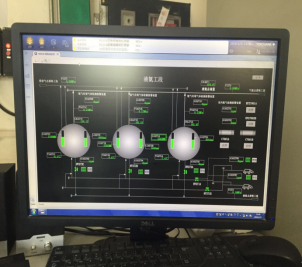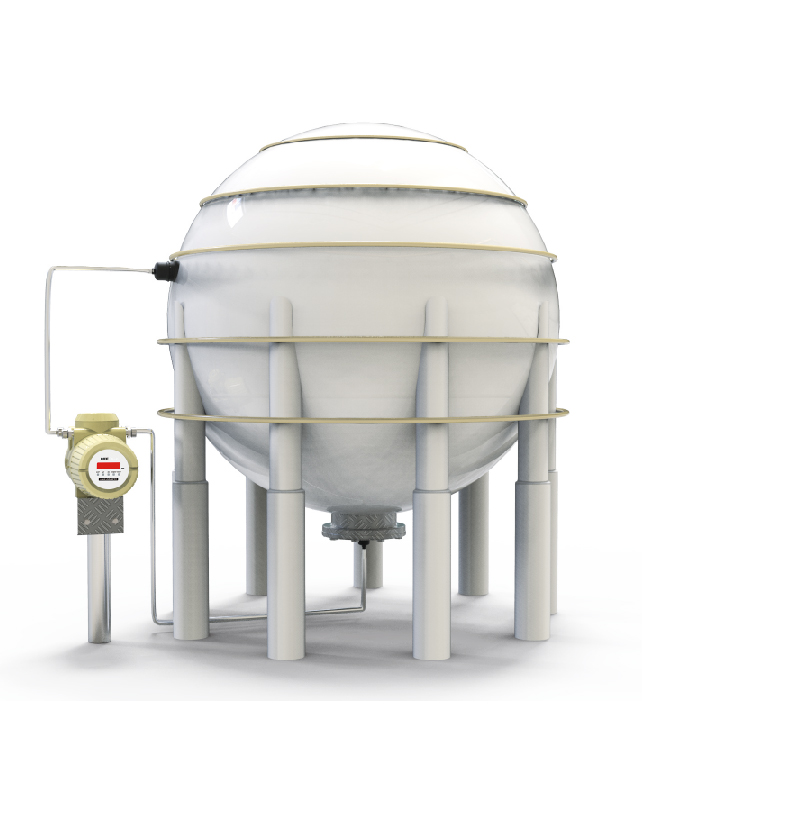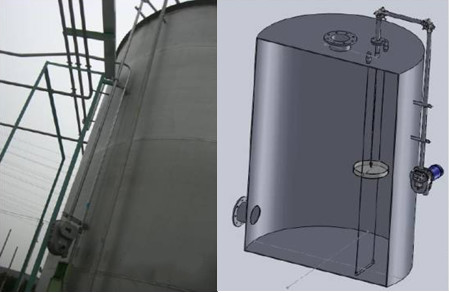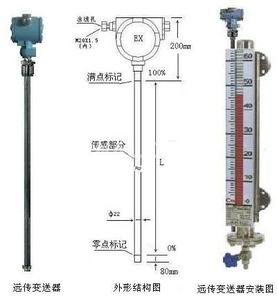Recyclable Paper Products,Paper Products,Eco Friendly Packing,Cut Resistant Paper Packing Ningbo Ascent paper products co.,ltd , https://www.zjascentpaper.com
Due to the characteristics of liquid ammonia, the measurement of the liquid level in the liquid ammonia ball tank has always been a problem. At the beginning, we chose the liquid level gauge of the steel belt. The float and the steel belt were easy to be stuck and the use effect was not good. Then we tested the differential pressure liquid. The position gauges, magnetic flap level gauges and servo level gauges are not very satisfactory.
By chance, we contacted Xi'an Dinghua Company's patented product, the external level gauge, which is simple to install, does not open holes, does not move, and does not stop. The non-contact measurement level is very safe. In addition, a series of patented technologies, automatic calibration and micro-vibration analysis are used to ensure that the instrument operates reliably and accurately, which solves the problem of liquid level measurement in liquid ammonia ball tanks. The external level gauge has been used for nearly 3 years and has been operating very steadily.
Keywords: ammonia-alkali method, liquid ammonia, spherical tank, liquid level, difficult to measure, external level gauge, automatic calibration, micro-vibration analysis; safety; environmental protection; precision 1. Introduction Qinghai Multicolored Alkali Industry Co., Ltd. is an annual output 1.1 million tons of soda ash in chemical companies, the company mainly produces industrial heavy soda (sodium carbonate). Heavy soda ash has a wide range of application industries in most chemical companies. It is known as the “mother of chemical industry†and has a very important role in the development of the national economy. Its output and consumption are usually measured as a national industry. One of the signs of development level.
In the process of automatic control, ammonia as the main raw material, liquid ammonia storage equipment - liquid ammonia spherical tanks become an important part of the production base enterprises. Liquid ammonia, under normal conditions, ammonia gas is a colorless gas, irritating odor, easy to be liquefied, in the warming or reducing pressure, liquid ammonia can be rapidly evaporated, and absorb a lot of heat. Ammonia has a certain degree of corrosion, carbonized ammonia is more corrosive, and can easily cause damage to pipes, valves and other equipment, resulting in ammonia leakage. Ammonia burns the mucous membranes of the skin, eyes, and respiratory organs. Excessive inhalation can cause lung swelling and death. Ammonia explosion limit of 16 to 25% (the most flammable concentration of 17%).
According to the Notice of the State Council's Production Safety Committee on Deepening the Special Treatment of Liquid Ammonia Utilization in Ammonia-related Refrigeration Enterprises (SNC [2013] 6
No. ) and the "Circular on Announcement of the First Batch of Hazardous Chemicals Listed for Key Supervision" by the State Administration of Safety Supervision (Safety Supervisors No. 3 [2011] 95
No. ) and “Notice on Announcement of Catalogue of Hazardous Chemical Processes for Key Supervision†(Safety Supervisor Administration No. 3 [2009] No. 116) requirements: Production and storage devices for enterprises that use key hazardous chemicals as a major source of hazardous chemicals should be Equipped with an automatic control system to realize real-time monitoring of ammonia gas concentration, temperature, pressure, liquid level, and other important parameters.
Liquid ammonia is one of the major hazard sources designated by the state. The real-time monitoring of the liquid ammonia level is very important for the safety production of chemical companies. The storage of liquid ammonia requires pressure and low temperature, so the liquid level measurement of the liquid ammonia spherical tank has been plagued by the alkali production enterprises for a long time. The use of conventional liquid level meters is not ideal. At the beginning, we installed a steel belt level gauge. Because of the strong corrosiveness of liquid ammonia in the tank, it will not be used for a long time because the float and the steel belt will be stuck and broken. This will result in the inability to use the product. , it is now disabled. Later, the company selected a differential pressure transmitter for auxiliary measurement. The change of the upper and lower pressure difference was used to measure the liquid level. Since the pressure gauge at the lower part of the container could not be used to obtain pressure in the tank, it could only be installed on the bottom of the tank or the outlet of the medium. , It is easy to cause blockage or negative pressure, which can not reach the purpose of accurately measuring the liquid level. After that, we also tried two level gauges, with remote magnetic level gauges and servo level gauges, and the results were not satisfactory.
The liquid ammonia spherical tank is a special (pressured low temperature) container. It is inconvenient to open holes and heat the tank, and other input type liquid level measuring instruments are not convenient to install and use. Therefore, the level measurement of liquid ammonia spherical tanks is not possible. The problem has not been completely solved and satisfactory results cannot be achieved. In 2014, the company came into contact with Xi'an Dinghua ELL-FI external measurement level gauge. He heard that the external measurement level gauge can realize completely non-contact measurement. The liquid level measurement head can be installed outside the container to monitor the liquid level in the tank. , not affected by pressure, temperature, and medium density in the tank. If we can do this, we will be able to solve the problem of measuring the liquid level in the liquid ammonia ball tank of the company. We decided to have a chance to try out the external level gauge.
2. The application of state opportunities came and in April 2014, the Design Institute also recommended to us that Xi'an Dinghua's production of external level gauges has been designed in many other units, and the use effect is very good. So we Xi'an Dinghua's ELL-FI external measurement level meter was used (see Figure 1). In the company's three 9.2m diameter, volume 407m3 liquid ammonia spherical tank trial installed three external level gauge, used so far, the instrument level tracking accuracy, reliable operation. The ELL-FI external measurement level gauge realizes the isolation measurement, and the liquid ammonia level in the tank can be monitored outside the tank. The installation is convenient and safe, and the adjustment is simple. No opening or clearing can be required, and no opening is made in the tank. No fire, no parking does not affect normal production, and has been unanimously approved by the on-site operations personnel and instrument maintenance personnel. 
3. The operating principle of the external measuring level gauge and several other level gauges 3.1 The external measuring level gauge ELL-FI external measuring level gauge is an intelligent field transmitter type instrument, and the liquid level measuring head is adsorbed on the storage tank At the bottom, the instrument explosion-proof mainframe is installed near the container under test and is far from the 4-20mA/Hart protocol/Modbus fieldbus/industrial Ethernet (see Figure 2). 
3.1.1 Development history of the external level measurement technology The concept of “external measurement fluid level†was proposed in the 1990s by Prof. Wang Dinghua, founder of Xi'an Dinghua, and invented the ELL external measurement level gauge. It is a kind of instrument that uses the principle of sonar distance measurement and “micro-vibration analysis†technology to measure the liquid level from outside the container. It does not need to open holes in the tank wall, does not use flanges, and does not contact the liquid and vapor in the tank. Installation, online maintenance, is a completely non-contact, true external level meter (Figure 3). Since it was the world's first external level gauge for the first time in more than 20 years, the stability and reliability of Dinghua's products can be trusted. We also learned about them from other chemical companies. Their services are in the industry. The word of mouth is also very good. 
3.1.2, The basic principle is the principle of sonar ranging, "micro-vibration analysis" technology 3.1.2.1, sonar ranging principle sonar ranging principle is the ELL external measurement level gauge? The basis of the external level measurement.
The sound waves are emitted by a liquid level measuring head that is adsorbed on the bottom of the tank, penetrates the tank wall to propagate in the liquid medium in the tank, reaches the liquid surface to reflect and form an echo, and the echo signal reaches the bottom of the tank, penetrates the tank wall, and then passes the liquid level. The measuring head receives the returned acoustic wave signal and returns it to the host. The host calculates the liquid level according to the formula distance (D)=speed (S)×time (T) (see figure 4). Distance (D): The height of the liquid we want to obtain;
Speed ​​(S): the speed of propagation of sonar waves in a liquid medium. The propagation speeds of sonar waves in different media are different.
Time (T): The time during which a sonar wave forms an echo in a liquid. 
3.1.2.2. "Microvibration Analysis" Technology "Microvibration analysis" technology is the core patent technology of Xi'an Dinghua and is the guarantee for accurate measurement and reliable operation of the ELL external measurement level gauge.
Due to the difference in different working conditions, such as: different tank types, different degrees of sedimentation in the tank, different media characteristics, etc., the echo signals received by the liquid level measuring head adsorbed on the outside of the tank wall will not only have the liquid level. Signals, as well as some other interference signals, such as dead zone signals, occluder signals, etc., ELL external level gauges with "micro-vibration analysis" technology will automatically determine the correct level signal, and always follow the signal to display accurately Level.
"Micro-vibration analysis" technology is a powerful external measurement sonar signal processing technology. This advanced sonar signal processing technology is based on the application experience of nearly one thousand users of external level gauges by Xi'an Dinghua Company. It is actually used in nearly hundreds of operating conditions in nearly ten thousand sets of external level gauges. , Through the massive accumulation of industrial field data for more than 20 years, in-depth summary, forming advanced judgment methods and algorithms.
3.1.2.3 Automatic Calibration Function The ELL external measurement level gauge has an “auto calibration function†and is also one of the patented technologies of Xi'an Dinghua. It is a guarantee that the ELL external measurement level gauge can accurately measure at any time.
Principle of automatic calibration: When the liquid composition and density of the same liquid change greatly, the propagation speed of the acoustic wave in the liquid will also change, which may bring about measurement error. In order to ensure the measurement accuracy of the instrument, it can be in the container. Add the calibrator and use the calibration probe 1 to measure the standard length of the liquid column in the calibrator. The standard length is 1m (Figure 5). Since the calibration probe and the liquid level measuring head work in the same way, we can pass the speed (S). ) = Distance (D) / Time (T), the speed of sound waves in the liquid in the calibrator. 
Because the liquid in the calibrator communicates with the liquid in the container, the liquid temperature and composition in the calibrator are the same as the liquid in the container, and the propagation speed of the sound wave is also the same, so the accurate propagation speed of the sound wave in the medium in the container under the current environment can be obtained. . The meter will automatically select the corrected sound wave propagation speed for calculation. The length of the liquid column in the calibrator is the standard 1m, and the calibrator is equivalent to a ruler. The calibration measuring head 1 continuously sends the result obtained by the ruler to the CPU, and the CPU calculates the exact height of the liquid level according to the result. The resulting liquid level is not affected by changes in liquid temperature and composition.
If the calibrator is unconditionally installed in the container, the measuring head 2 can be calibrated to be mounted on the equator of the ball can, and the exact diameter of the container is known as a ruler for automatic calibration.
3.1.3. Technical advantage The sonar is the sound navigation and distance measurement. It is a kind of underwater wave propagation using the characteristics of sound waves to detect underwater targets. It is a kind of ranging technique in liquids. It was applied more than 100 years ago. The development of sonar ranging has become a very reliable technology. The technological advantage of Xi'an Dinghua is to find the strongest penetration ability and the best anti-interference ability among the different wave strength, wavelength, and wave frequency sound wave series. After more than 20 years of field data accumulation, they have been analyzed and improved. Currently, it has been widely used in petroleum and chemical companies, and has solved many companies' "dangerous chemicals" level measurement.
3.2, differential pressure level gauge 3.2, differential pressure level gauge differential pressure level gauge is to measure the high and low pressure difference, calculate the level pressure in the measurement container to measure the liquid level, and then converted by the conversion component The current signal is transmitted to the electrical components of the control room. Differential pressure level gauge is mainly used for level measurement of sealed pressure vessels. The difference between the upper and lower differential pressure level changes. (Figure 6). 
3.3, steel belt level gauge buoyancy principle. It puts a float or floating plate into the tank under test. The float or floating plate floats on the surface of the liquid and moves along with the liquid surface moving up and down. At the same time, it drives the steel belt connected to it and the steel belt is displaced. The counter The level is displayed by recording the scale change on the strip. (Figure 7)
The transmitter determines the height of the liquid level through a combination of different holes and holes (circular holes, square holes, and rectangular holes of different lengths) corresponding to different liquid levels on the steel strip, and performs far transmission. 
3.4, magnetic flap level gauge Magnetic flap level gauge It is the use of the principle of the communicator, consists of the main tube, float, column display and electrical components. The main body tube is the cavity that contains the float ball. It forms a communicating device with the container through the flange or other interface. So the floating ball in the cavity will rise and fall as the liquid level in the container rises and falls; Column display (composed of a row of iron-chromium-cobalt permanent magnets, one side is white and one side is red); the permanent magnetic steel is installed at the boundary where the float sinks into the liquid and the floating part, and it moves up and down with the floating surface Its magnetic transmission through the shell to the magnetic display of the column display, pushing the magnetic plate flip 180 °, the junction between the two colors is the height of the liquid surface. (Figure 8) 
3.5, servo level gauge buoyancy principle (Archimedes principle). And adopts high-precision force sensor and high-precision servo motor system and measuring drum. By measuring the change of the wire tension caused by the increase or decrease of the buoyancy force of the float, the controller issues an instruction. The servo motor drives the magnetic measurement with a certain step. The drum rotates and drives the float to continuously track the change of the liquid level. At the same time, the counter records the number of rotations of the servo motor and automatically calculates the displacement of the measuring float, ie, the amount of change of the liquid level. (Figure 9) 
4. Characteristics of several level gauges Comparison 4.1? External gauge level gauge External gauge level gauge Continuously and accurately measure the level in the tank from outside the tank, completely avoid contact with the liquid and gas in the tank, achieving true isolation measuring. Therefore, the characteristics are as follows:
Accurate, reliable, safe, environmentally friendly, convenient, economical, and resistant. No need to stop production on-line installation and maintenance, and no holes or holes in containers.
4.1.3. Disadvantages Externally measured level gauges have dead zones, usually 8-10% of full tank range.
4.2 differential pressure level gauge 4.2.1, advantages:
a. Anti-overload and anti-impact ability, over 5 times of overload range;
b. High stability;
c, small temperature drift, unique product structure, small size, light weight, easy installation and maintenance.
4.2.2, Disadvantages:
a, gas-phase capillary easy to plug;
b, need to measure the exact liquid density in real time;
c. It is necessary to stop production, clean cans and open cans during installation.
4.3 strip level gauge 4.3.1, advantages:
Simple structure, intuitive reading 4.3.2, disadvantages:
a. High installation accuracy;
b. The guide wire rope will wear out with the fluctuation of the liquid surface, resulting in damage;
c, steel belt easy card.
4.4, magnetic flap level gauge 4.4.1, advantages a, a wide range of applications, various forms of installation;
b, resistance to vibration, can adapt to fluctuations in liquid level, simple structure, easy installation, low maintenance costs.
4.4.2ã€, disadvantage a, reed switch failure will lead to false liquid level;
b, the bottom flange is easily blocked by impurities, resulting in inconsistency between the liquid level in the tank and the liquid level in the cavity;
c. Flange holes must be opened in the tank during installation to increase the risk of leakage;
d, can not be installed online.
4.5, servo level gauge 4.5.1, advantages:
It can not only measure the liquid level, but also has the function of density measurement, oil-water interface measurement, average density and density distribution measurement of the medium, and high accuracy.
4.5.2, disadvantages:
a. When the measured medium viscosity is high, and there are wall hanging and sticky characteristics, the servo liquid level meter will have a large measurement error in the measurement, and is not suitable for application in the level measurement of such media.
b. broken wire, float lost.
5. Installation requirements 5.1 External level gauge 5.1.1 Because it is installed outside the tank, it does not need to destroy the structure of the tank. The instrument is very safe to use. It is not necessary to open the hole in the tank, nor does it need to be on the spot. Just use The strong magnetic ring of the measuring head is adsorbed on the tank body.
5.1.2 The instrument host only needs to be fixed at the site of the 2-inch riser, easy installation and removal, the instrument can reach ExdIIBT6, CT6 explosion-proof, WF1 grade anti-corrosion, IP65, IP67 waterproof, can be suitable for liquid ammonia spherical tank site Working conditions.
5.2, differential pressure level gauge reserved flange hole in advance, the installation needs to connect the pressure tube, there is a certain safety risk. The accuracy is low and the pressure gauge needs to be calibrated frequently.
5.3, steel belt level gauge hole installation, generally used for atmospheric pressure vessels, high installation requirements, requires professional on-site installation and commissioning.
5.4, ​​magnetic flap level gauges need to open the flange hole installation, large range (greater than 3 meters) requires a number of magnetic flap display connection, need to open more flange holes, increase the risk of leakage;
5.5. The servo level gauge reserves the flange hole in advance. Prior to installation, it is necessary to install the conduit in the tank. Every year, it is necessary to re-calibrate the zero point once.
6. Concluding remarks Since the beginning of 2013, Xi'an Dinghua External Measurement Level Gauge has been used for nearly 3 years. Due to the requirement of national regulations, two or more different principles must be installed on the “dangerous chemicals†tank. The liquid level meter, so at the time the liquid ammonia ball tank also installed a radar level gauge, has been compared to use (Figure 10). Compared with the use effect for several years, the external test runs more stable, the measurement is more accurate, and the maintenance amount is smaller. The company has played a positive role in the stable and safe operation of the liquid ammonia tank area, which is a major hazard source of the company. 
Note: One trend line is the ELL external level gauge; the other is the radar level gauge.
references:
(1) Petrochemical Automatic Control Design Manual ISBN 7-5025-2696-X
(2) Automation Instrument Troubleshooting ISBN 7-5025-4197-7
(3) "level gauge measuring the outer Manual", OF: West Anding Hua Electronics Co., Ltd. (4) "external level gauge measurement sample selection" OF: West Anding Hua Electronics Co., Ltd. (5) "ELL outside the enterprise level gauge measurement standards", author: West Anding Hua Electronics Co., Ltd. (6) the State Administration of Work safety "regarding the List of hazardous chemicals announced the first batch of key regulatory notice" (Work safety Explorer tris [2011] No. 95)
(7) "Notice on Announcement of Catalogue of Key Chemical Processes for Hazardous Chemical Supervision" (Safety Supervisor Administration No. [2009] No. 116)
(8) Safety Production Law of the People's Republic of China (Order No. 70 of the President of the People's Republic of China)
(9) Regulations on the Administration of Dangerous Chemicals Safety (Order No. 344 of the State Council)
(10) "Implementation Measures for Production Safety Permits for Dangerous Chemicals Production Enterprises" (Order No. 10 of the National Safety Supervision Bureau)
Abstract: The soda project started in 2013 in our company adopts ammonia-alkali soda ash. Ammonia is the main raw material. Under normal conditions, ammonia is a colorless gas, which has irritating odor and is easily liquefied. When the temperature is raised or pressure is reduced, ammonia can be used. Evaporates rapidly and absorbs a lot of heat. Ammonia has a certain degree of corrosion, carbonized ammonia is more corrosive, and can easily cause damage to pipes, valves and other equipment, resulting in ammonia leakage. Ammonia burns the mucous membranes of the skin, eyes, and respiratory organs. Excessive inhalation can cause lung swelling and death. Ammonia explosion limit of 16 to 25% (the most flammable concentration of 17%). There are also numerous applications in the industrial field. However, with the wide use of liquid ammonia, some companies fail to monitor the liquid ammonia, and it is easy to cause many deaths and injuries. Liquid ammonia is one of the major hazard sources designated by the country.
Figure 1: ELL-FI-DE External Level Gauge
Figure 2: External level gauge remote DCS level display
Figure 3: External installation of ELL-FI level gauge
Figure 4: How ELL measures the level gauge
Figure 5: calibration diagram of ELL-FI-DE level gauge
Figure 6: Differential pressure level gauge
Figure VII: Steel Level Gauge
Figure 8: Magnetic flap level gauge
Figure 9: Servo Level Gauge
Figure 10: DCS Level Trend